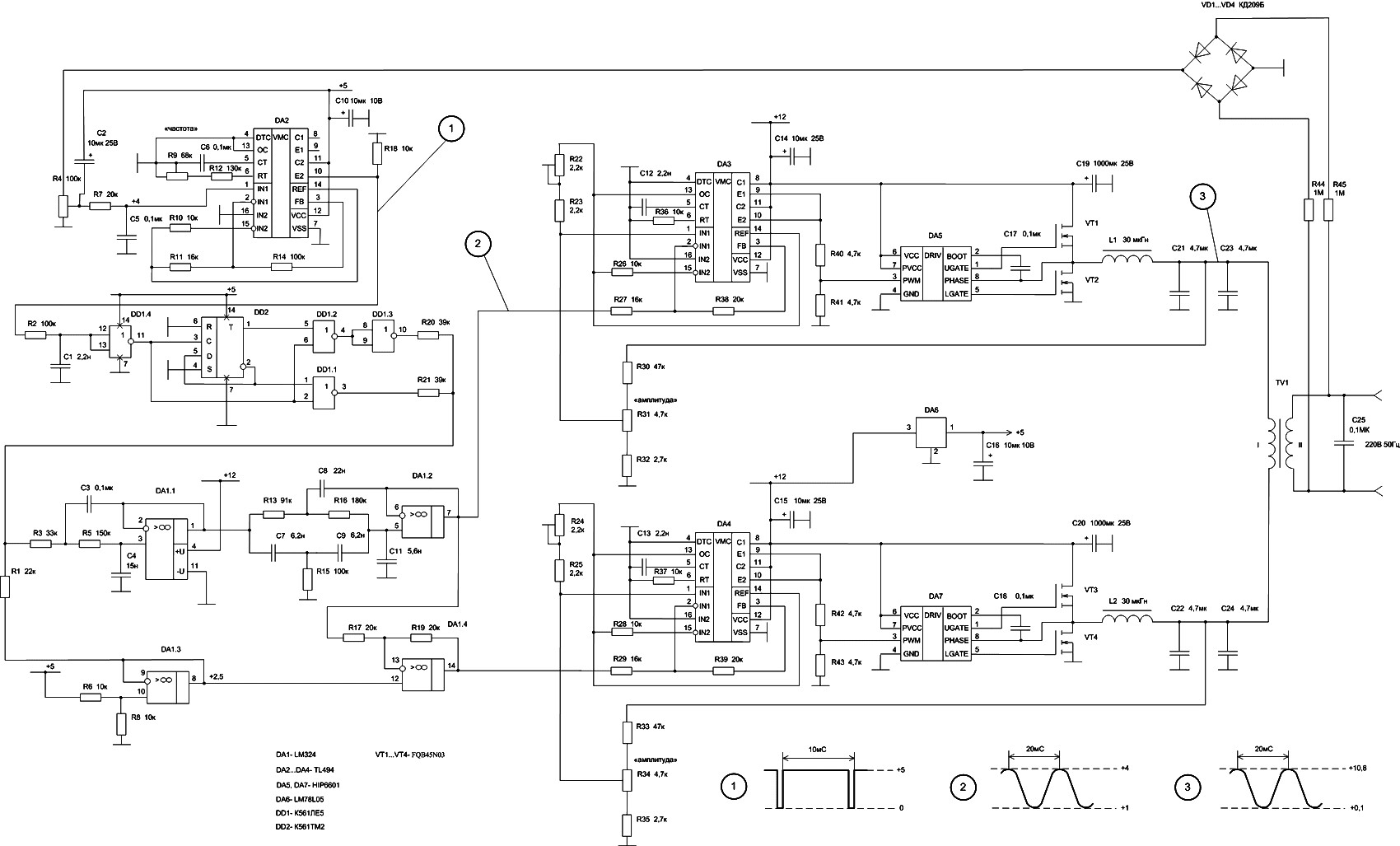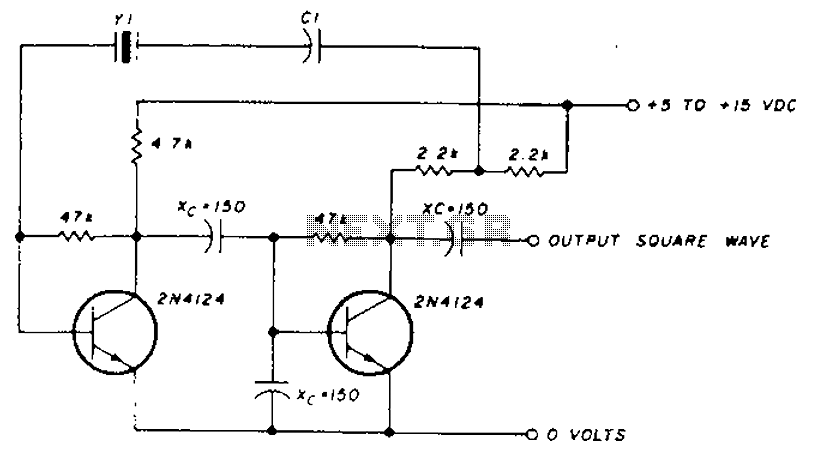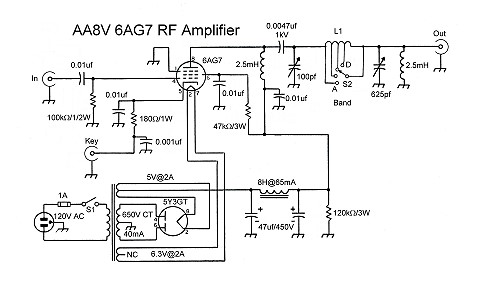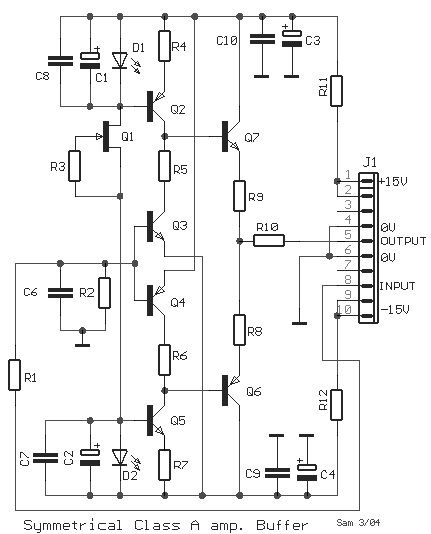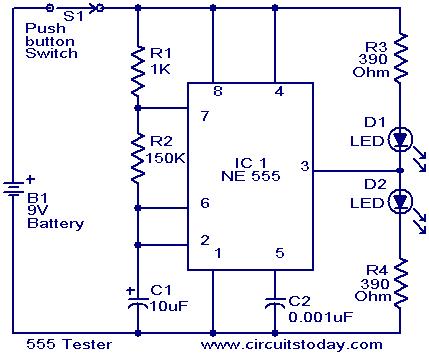
Amplifier Output Delay with Relay Schematic Diagram
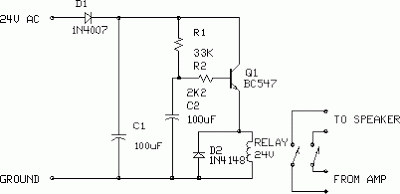
This is a minimal circuit designed for individual audio amplifier projects to control the presenter output relay. The purpose of this circuit is to manage the relay that activates the speaker output within the audio amplifier. The circuit introduces a time delay of approximately 5 seconds after power-up before the speakers are connected to the amplifier output, preventing any unpleasant sounds from the speakers. Another feature of this circuit is that it disconnects the speakers immediately when the power to the amplifier is turned off, thereby avoiding undesirable noises when the equipment is powered down. When power is applied to the circuit, the AC voltage charges capacitor C1. Subsequently, capacitor C2 begins to charge gradually through resistor R1. As the voltage across C2 increases, the emitter output voltage of transistor Q1 rises concurrently with the voltage on C2. Once the output voltage of transistor Q2 reaches a sufficient level (typically around 16-20V), the relay activates, connecting the speakers to the amplifier output. The delay time before the relay conducts is typically around 5 seconds, though this can vary based on the values of C2, the relay voltage, and the circuit input voltage. When the power is switched off, C1 discharges its energy relatively quickly, while C2 discharges through resistor R2, leading to the speakers being disconnected from the amplifier output in less than 0.5 seconds.
This circuit is structured around a few key components: capacitors C1 and C2, resistors R1 and R2, and transistors Q1 and Q2, along with a relay. Capacitor C1 serves as a primary filter capacitor, stabilizing the input voltage and ensuring smooth operation during power-up. Capacitor C2 is critical for creating the delay; it charges slowly, allowing time for the amplifier to stabilize before the speakers are connected. Resistor R1 controls the charging rate of C2, while resistor R2 facilitates the discharge process when power is removed, ensuring a rapid disconnect of the speakers.
Transistor Q1 functions as a switch that responds to the voltage across C2. As C2 charges, the base-emitter voltage of Q1 increases, turning it on and allowing current to flow. This, in turn, affects the operation of Q2, which is responsible for driving the relay. The relay itself acts as an electromechanical switch, providing a physical connection to the speakers only when the circuit conditions are met.
The design ensures that the speakers are not subjected to power surges or noise during the amplifier's turn-on and turn-off phases, enhancing the overall audio experience. The delay mechanism is crucial in audio applications, where abrupt changes in signal can result in audible pops or thumps, which could be damaging to both the speakers and the listener's experience. The circuit's simplicity and effectiveness make it an ideal solution for audio amplifier projects requiring speaker protection.This is a minimal circuit which I built to individual of my audio amplifier projects to control the presenter output relay. The end of this circuit is to control the relay which turns on the speaker output relay within the audio amplifier.
The impression of the circuit is time lag around 5 seconds ofter the power up until the speakers are switched to the amplifier output to circumvent grating pound sound from the speakers. an added appear of this circuit is so as to is disconnects the orator just now once the power within the amplifier is finish inedible, so avoiding every now and then nasty sounds as soon as you trip the equipments inedible. Followed by power is functional to the power input of the circuit, the categorical stage of AC voltage charges C1.
Then C2 starts to charge little by little through R1. while the voltage in C2 rises, the emitter output voltage of Q1 rises concurrently with voltage on C2. as the output voltage of Q2 is anticyclone an adequate amount of (typically around 16. 20V) the relay goes to on state and the relay witches associate the speakers to the amplifier output.
It takes typically around 5 seconds in the same way as power up until the relay starts to conduct (next to absolute epoch depends on the size of C2, relay voltage and circuit input voltage). as the power is switched rotten, C1 force not tied up it`s energy quite quickly. and C2 will transpire charged quite quickly through R2. into excluding than 0. 5 seconds the speakers are disconnected from the amplifier output. You are reading the Circuits of Amplifier Output Delay with Relay And this circuit permalink url it is
🔗 External reference
This circuit is structured around a few key components: capacitors C1 and C2, resistors R1 and R2, and transistors Q1 and Q2, along with a relay. Capacitor C1 serves as a primary filter capacitor, stabilizing the input voltage and ensuring smooth operation during power-up. Capacitor C2 is critical for creating the delay; it charges slowly, allowing time for the amplifier to stabilize before the speakers are connected. Resistor R1 controls the charging rate of C2, while resistor R2 facilitates the discharge process when power is removed, ensuring a rapid disconnect of the speakers.
Transistor Q1 functions as a switch that responds to the voltage across C2. As C2 charges, the base-emitter voltage of Q1 increases, turning it on and allowing current to flow. This, in turn, affects the operation of Q2, which is responsible for driving the relay. The relay itself acts as an electromechanical switch, providing a physical connection to the speakers only when the circuit conditions are met.
The design ensures that the speakers are not subjected to power surges or noise during the amplifier's turn-on and turn-off phases, enhancing the overall audio experience. The delay mechanism is crucial in audio applications, where abrupt changes in signal can result in audible pops or thumps, which could be damaging to both the speakers and the listener's experience. The circuit's simplicity and effectiveness make it an ideal solution for audio amplifier projects requiring speaker protection.This is a minimal circuit which I built to individual of my audio amplifier projects to control the presenter output relay. The end of this circuit is to control the relay which turns on the speaker output relay within the audio amplifier.
The impression of the circuit is time lag around 5 seconds ofter the power up until the speakers are switched to the amplifier output to circumvent grating pound sound from the speakers. an added appear of this circuit is so as to is disconnects the orator just now once the power within the amplifier is finish inedible, so avoiding every now and then nasty sounds as soon as you trip the equipments inedible. Followed by power is functional to the power input of the circuit, the categorical stage of AC voltage charges C1.
Then C2 starts to charge little by little through R1. while the voltage in C2 rises, the emitter output voltage of Q1 rises concurrently with voltage on C2. as the output voltage of Q2 is anticyclone an adequate amount of (typically around 16. 20V) the relay goes to on state and the relay witches associate the speakers to the amplifier output.
It takes typically around 5 seconds in the same way as power up until the relay starts to conduct (next to absolute epoch depends on the size of C2, relay voltage and circuit input voltage). as the power is switched rotten, C1 force not tied up it`s energy quite quickly. and C2 will transpire charged quite quickly through R2. into excluding than 0. 5 seconds the speakers are disconnected from the amplifier output. You are reading the Circuits of Amplifier Output Delay with Relay And this circuit permalink url it is
🔗 External reference

